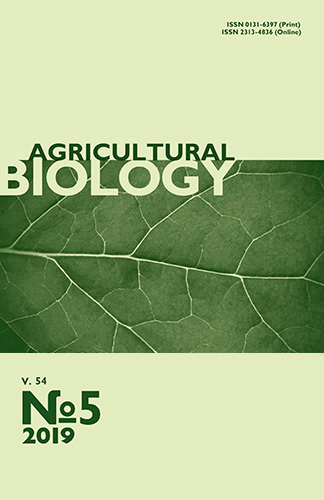doi: 10.15389/agrobiology.2019.5.934eng
UDC: 633.1:581.143.6
Acknowledgements:
The authors are grateful to the employees of the Center for Digital Technologies (KazNIIZiR LLP) for the data statistical processing.
Supported financially by Science Committee of the Ministry of Education and Science of the Republic of Kazakhstan under budget program 217 “Development of science”, subprogram 102 “Grant funding for research”, IRN project No. AP05132430
EFFECT OF ZEATIN ON in vitro EMBRYOGENESIS AND PLANT REGENERATION FROM ANTHER CULTURE OF HEXAPLOID TRITICALE
(× Triticosecale Wittmack)
R.S. Yerzhebayeva, M.A. Abdurakhmanova,
Sh.O. Bastaubayeva, D. Tadjibayev
LLP Kazakh Research Institute of Agriculture and Plant Growing, 1, Erlepesov str., Almalybak v., Karasay District, Almaty Region, 040909 Republic of Kazakhstan, e-mail raushan_2008@mail.ru (✉ corresponding author), abduraxmanova58@inbox.ru, sh.bastaubaeva@mail.ru, daniyar.taj@gmail.com
ORCID:
Yerzhebayeva R.S. orcid.org/0000-0003-4585-8505
Bastaubayeva Sh.O. orcid.org/0000-0003-2588-5880
Abdurakhmanova M.A. orcid.org/0000-0002-1337-0647
Tadjibayev D. orcid.org/0000-0002-5956-2644
Received August 16, 2019
To achieve results sooner, cereal crop selection programs usually combine conventional methods, such as selection of parents and large-scale cross-breeding with haploid technology, a methodology which allows obtaining homozygous lines from the F1 hybrids. Methods of androgenesis (anther culture and isolated microspore culture techniques) have gained widespread use for selection of wheat and triticale. Currently, the main issue for the androgenesis in Triticale is the low efficiency of green plant regeneration. The present work, for the first time ever, utilizes cytokinin zeatin as an exogenic phytohormone in the induction medium, and determines its concentration optimal for improving embryo formation and green plant regeneration from the triticale anther culture. The aim of this research is to increase efficiency of the triticale anther culture, and study the effects of adding cytokinin zeatin to the nutrient medium on embryogenesis induction and regeneration. Two lines of spring triticale, YaTKh-327-11 and Zernokormovoye 5 (facultative), and two lines of winter triticale, T-968 and T-45, were used. Donor plants for the haploid technology were grown in the irrigated field of Kazakh Research Institute of Agriculture and Plant Growing LLP (Kazakhstan, Almaty Region). Cut spikes were subjected to low temperature (4 °C for 14 days), and then the anthers, after they were isolated, to high temperature (32 °C for 3 days). The spikes were sterilized with 0.1 % solution of mercuric chloride. Modified mW14 medium was used as the basic nutrient medium for embryogenesis induction. Five variants of nutrient medium were studied, with concentration of phytohormone zeatin gradually increasing in each subsequent variant (0.2 mg/l, 0.4 mg/l, 0.6 mg/l, 0.8 mg/l, 1.0 mg/l), and medium without zeatin served as control. The study conducted on 4 genotypes of triticale has shown that addition of zeatin to the nutrient mediums in concentrations of 0.2-0.8 mg/l increased the rate of androgenic structure formation by 42.3-65.2 %. Maximal effect on the androgenic structure formation was achieved at 0.4 mg/l concentration of zeatin, with 112 androgenic structures (AS) per 100 anthers on average compared to 67.8 AS per 100 anthers in control group. In the embryogenesis inducing nutrient mediums with 0.4-0.6 mg/l zeatin concentrations the rate of embryogenesis was 16.9-24.1 % higher compared to the control, with embryos having bipolar structure, and producing stem and roots during the regeneration, which indicates positive effect of zeatin on differentiation and organogenesis of the dividing microspore cells. All the variants in the experiment showed a significant increase in the rate of regeneration compared to the control with no zeatin added. In embryos transplanted from the medium containing 0.6 mg/l zeatin the rate of green plant regeneration was the highest reaching 6.3 pcs/100 anthers. It has been established that addition of zeatin and the effect of genotype were the statistically significant factors for androgenic structure formation and regeneration. Efficiency of spontaneous chromosome doubling in triticale amounted to 26.5 %, which has allowed producing 97 double haploid lines from the promising lines of triticale without colchicination.
Keywords: triticale, anther culture, zeatin, embryo, regeneration, albino plants, green plants, spontaneous doubling.
REFERENCES
- Ayalew H., Kumssa T.T, Butler T.J., Ma X.F. Triticale improvement for forage and cover crop uses in the southern great plains of the United States. Front. Plant Sci., 2018, 9: 1130 CrossRef
- Ofitsial'naya statisticheskaya informatsiya. Posevnye ploshchadi sel'skokhozyaistvennykh kul'tur pod urozhai 2018 goda v Respublike Kazakhstan [Official statistical information. Area of crops for 2018 in the Republic of Kazakhstan]. Available http://stat.gov.kz/of-ficial/industry/14/statistic/7. Accessed 22.09.2018 (in Russ.).
- Eudes F., Chugh A. An overview of triticale doubled haploids. In: Advances in haploid production in higher plants. A. Touraev, B.P. Forster, S.M. Jain (eds.). Springer, Dordrecht, 2009: 87-96 CrossRef
- Lantos C., Bóna L., Boda K., Pauk J. Comparative analysis of in vitro anther- and isolated microspore culture in hexaploid triticale (× Triticosecale Wittmack) for androgenic parameters. Euphytica, 2014, 197(1): 27-37 CrossRef
- Würschum T., Tucker M.R., Maurer H.P. Stress treatments influence efficiency of microspore embryogenesis and green plant regeneration in hexaploid triticale (× Triticosecale Wittmack L.). In Vitro Cell. Dev. Biol. - Plant, 2014, 50(1): 143-148 CrossRef
- Würschum T., Tucker M.R., Maurer H.P., Leiser W. Ethylene inhibitors improve efficiency of microspore embryogenesis in hexaploid triticale. Plant Cell Tiss. Organ. Cult., 2015, 122(3): 751-757 CrossRef
- Oleszczuk S., Sowa S., Zimny J. Direct embryogenesis and green plant regeneration from isolated microspores of hexaploid triticale (× Triticosecale Wittmack) cv. Bogo. Plant Cell Rep., 2004, 22(12): 885-893 CrossRef
- Zheng M.Y., Konzak C.F. Effect of 2,4-dichlorophenoxyacetic acid on callus induction and plant regeneration in anther culture of wheat (Triticum aestivum L.). Plant Cell Rep., 1999, 19(1): 69-73 CrossRef
- Hassawi D.S., Qi J., Liang G.H. Effects of growth regulator and genotype on production of wheat and triticale polyhaploids from anther culture. Plant Breeding, 1990, 104(1): 40-45 CrossRef
- Ponitka A., Ślusarkiewicz-Jarzina A. The effect of liquid and solid medium on production of winter triticale (× Triticosecale Wittm.) anther-derived embryos and plants. Cereal Research Communications, 2007, 35(1): 15-22 CrossRef
- González J.M., Jouve N. Microspore development during in vitro androgenesis in triticale. Biologia Plantarum, 2005, 49(1): 23-28 CrossRef
- Lantos C., Páricsi S., Zofajova A., Weyen J., Pauk J. Isolated microspore culture of wheat (Tri-ticum aestivum L.) with Hungarian cultivars. Acta Biologica Szegediensis, 2006, 50(1-2): 31-35.
- Pauk J., Puolimatka M., Tóth K.L., Monostori T. In vitro androgenesis of triticale in isolated microspore culture. Plant Cell Tiss. Organ. Cult., 2000, 61: 221-229 CrossRef
- Broughton S. Ovary co-culture improves embryo and green plant production in anther culture of Australian spring wheat (Triticum aestivum L.). Plant Cell Tiss. Organ. Cult., 2008, 95(2): 185-195 CrossRef
- Kim K.M., Baenziger P.S. A simple wheat haploid and doubled haploid production system using anther culture. In Vitro Cell. Dev. Biol. - Plant, 2005, 41(1): 22-27 CrossRef
- Turaev A., Mishutkina Ya.V., Neskorodov Ya.B., Skryabin K.G. Sposob polucheniya digaploidnykh rastenii yachmenya iz kul'tiviruemykh mikrospor in vitro. Patent 2557389 (PF) MKI C12N15/82, A01H4/00, A01H1/04. FGBOU VO «Moskovskii gosudarstvennyi universitet im. M.V. Lomonosova» (RF) № 2013144618/10. Zayavl. 04.10.2013. Opubl. 10.04.2015. Byul. № 10 [Method for producing dihaploid barley plants from cultured microspores in vitro. Patent 2557389 (PF) MKI C12N15/82, A01H4/00, A01H1/04. FGBOU VO Lomonosov Moscow State University (RF) № 2013144618/10. Appl. 04.10.2013. Publ. 10.04.2015. Bul. № 10] (in Russ.).
- Zeatin (6[4-hydroxy-3-methyl-cis-2-butenylamino]purine). In: Encyclopedia of genetics, genomics, proteomics and informatics. Springer, Dordrecht, 2008 CrossRef
- Seldimirova O.A., Kudoyarova G.R., Kruglova N.N., Zaytsev D.Y., Veselov S.Y. Changes in distribution of zeatin and indole-3-acetic acid in cells during callus induction and organogenesis invitro in immature embryo culture of wheat. In Vitro Cell. Dev. Biol.- Plant, 2016, 52(3): 251-264 CrossRef
- Shri P.V., Davis T.M. Zeatin-induced shoot regeneration from immature chickpea (Cicer arietinum L.) cotyledons. Plant Cell Tiss. Organ. Cult., 1992, 28(1): 45-51 CrossRef
- Kumar R., Mamrutha H.M., Kaur A., Venkatesh K., Grewal A., Kumar R. Development of an efficient and reproducible regeneration system in wheat (Triticum aestivum L.). Physiol. Mol. Biol. Plants, 2017, 23(4): 945-954 CrossRef
- Santa-Maria M., Pecota K.V., Yencho C.G., Allen G., Sosinski B. Rapid shoot regeneration in industrial ‘high starch’ sweetpotato (Ipomoea batatas L.) genotypes. Plant Cell Tiss. Organ. Cult., 2009, 97(1): 109-117 CrossRef
- Hegde V., Partap P.S., Yadav R.C., Baswana K.S. In vitro androgenesis in Capsicum (Capsicum annuum L.). Int. J. Curr. Microbiol. App. Sci., 2017, 6(5): 925-933 CrossRef
- Dehkehan M.E., Moieni A., Movahedi Z. Effects of zeatin riboside, mannitol and heat stress on eggplantn (Solanum melongena L.) anther culture. Iranian journal of Genetics and Plant Breeding, 2017, 6(1): 16-26.
- Yerzhebayeva R.S., Abekova A.M., Ainebekova B.A., Urazaliyev K.R., Bazylova T.A., Daniyarova A.K., Bersimbayeva G.Kh. Influence of different concentrations of ascorbic and gibberellic acids and pH of medium on embryogenesis and regeneration in anther culture of spring triticale. Cytology and Genetics, 2017, 51(6): 448-454CrossRef
- Erzhebaeva R.S., Bersimbaeva G.Kh., Azirbaeva A.T. Materialy IV Mezhdunarodnoi konferentsii «Genofond i selektsiya rastenii»[Proc. IV Int. Conf. «Gene pool and plant breeding»]. Novosibirsk, 2018: 110-115 (in Russ.).
- Pausheva Z.P. Praktikum po tsitologii rastenii[Workshop on plant cytology]. Moscow, 1988 (in Russ.).
- Lantos C., Pauk J. Anther culture as an effective tool in winter wheat (Triticum aestivum L.) breeding. Russian Journal of Genetics, 2016, 52(8): 794-801 CrossRef
- Jia X., Zhuang J., Hu S., Ye C., Nie D. Establishment and application of the medium of anther culture of intergeneric hybridsof Triticum aestivum ´ Triticum-Agropyron. Sci. Agri. Sinica, 1994, 27: 83-87.
- Rubtsova M., Gnad H., Melzer M., Weyen J., Gils M. The auxins centrophenoxine and 2,4-D differ in their effects on non-directly induced chromosome doubling in anther culture of wheat (T. aestivum L.). Plant Biotechnol. Rep., 2012, 7(3): 247-255 CrossRef
- Eudes F., Amundsen E. Isolated microspore culture of Canadian 6· triticale cultivars. Plant Cell Tiss. Organ. Cult., 2005, 82(3): 233-241 CrossRef
- Tuvesson S., Ljungberg A., Johanson N., Karlsson K.-E., Suijs W., Josset J.-P. Large-scale production of wheat and triticale doubled haploids through the use of a single-anther culture method. Plant Breeding, 2000, 119(6): 455-459 CrossRef
- Germanà M.A. Anther culture for haploid and doubled haploid production. Plant Cell Tiss. Organ. Cult., 2011, 104(3): 283-300 CrossRef
- Ślusarkiewicz-Jarzina A., Ponitka A. Efficient production of spontaneous and induced doubled haploid triticale plants derived from anther culture. Cereal Research Communications, 2003, 31: 289-296.












